Stress intensity factor

The stress intensity factor, , is used in fracture mechanics to predict the stress state ("stress intensity") near the tip of a crack caused by a remote load or residual stresses.[1] It is a theoretical construct usually applied to a homogeneous, linear elastic material and is useful for providing a failure criterion for brittle materials, and is a critical technique in the discipline of damage tolerance. The concept can also be applied to materials that exhibit small-scale yielding at a crack tip.
The magnitude of depends on sample geometry, the size and location of the crack, and the magnitude and the modal distribution of loads on the material.
Linear elastic theory predicts that the stress distribution () near the crack tip, in polar coordinates () with origin at the crack tip, has the form [2]
where is the stress intensity factor (with units of stress length1/2) and is a dimensionless quantity that varies with the load and geometry. This relation breaks down very close to the tip (small ) because as goes to 0, the stress goes to . Plastic distortion typically occurs at high stresses and the linear elastic solution is no longer applicable close to the crack tip. However, if the crack-tip plastic zone is small, it can be assumed that the stress distribution near the crack is still given by the above relation.
Stress intensity factors for various modes

Three linearly independent cracking modes are used in fracture mechanics. These load types are categorized as Mode I, II, or III as shown in the figure. Mode I, shown to the left, is an opening (tensile) mode where the crack surfaces move directly apart. Mode II is a sliding (in-plane shear) mode where the crack surfaces slide over one another in a direction perpendicular to the leading edge of the crack. Mode III is a tearing (antiplane shear) mode where the crack surfaces move relative to one another and parallel to the leading edge of the crack. Mode I is the most common load type encountered in engineering design.
Different subscripts are used to designate the stress intensity factor for the three different modes. The stress intensity factor for mode I is designated and applied to the crack opening mode. The mode II stress intensity factor, , applies to the crack sliding mode and the mode III stress intensity factor, , applies to the tearing mode. These factors are formally defined as:[3]
Relationship to energy release rate and J-integral
The strain energy release rate () for a crack under mode I loading is related to the stress intensity factor by
where is the Young's modulus and is the Poisson's ratio of the material. The material is assumed to be an isotropic, homogeneous, and linear elastic. Plane strain has been assumed and the crack has been assumed to extend along the direction of the initial crack. For plane stress conditions, the equivalent relation is
For pure mode II loading, we have similar relations
For pure mode III loading,
where is the shear modulus. For general loading in plane strain, the relationship between the strain energy and the stress intensity factors for the three modes is
A similar relation is obtained for plane stress by adding the contributions for the three modes.
The above relations can also be used to connect the J-integral to the stress intensity factor because
Critical stress intensity factor
The stress intensity factor, , is a parameter that amplifies the magnitude of the applied stress that includes the geometrical parameter (load type). Stress intensity in any mode situation is directly proportional to the applied load on the material. If a very sharp crack can be made in a material, the minimum value of can be empirically determined, which is the critical value of stress intensity required to propagate the crack. This critical value determined for mode I loading in plane strain is referred to as the critical fracture toughness () of the material. has units of stress times the root of a distance. The units of imply that the fracture stress of the material must be reached over some critical distance in order for to be reached and crack propagation to occur. The Mode I critical stress intensity factor, , is the most often used engineering design parameter in fracture mechanics and hence must be understood if we are to design fracture tolerant materials used in bridges, buildings, aircraft, or even bells. Polishing cannot detect a crack. Typically, if a crack can be seen it is very close to the critical stress state predicted by the stress intensity factor.
G–criterion
The G-criterion is a fracture criterion that relates the critical stress intensity factor (or fracture toughness) to the stress intensity factors for the three modes. This failure criterion is written as[4]
where is the fracture toughness, for plane strain and for plane stress. The critical stress intensity factor for plane stress is often written as .
Examples of stress intensity factors
Infinite plate: Uniform uniaxial stress
|
The stress intensity factor for a through crack of length , at right angles, in an infinite plane, to a uniform stress field is [3] |
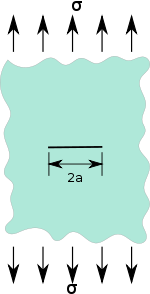 Crack in an infinite plate under mode I loading. |
Penny-shaped crack in an infinite domain
|
The stress intensity factor at the tip of a penny-shaped crack of radius in an infinite domain under uniaxial tension is [5] |
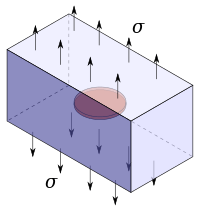 Penny-shaped crack in an infinite domain under uniaxial tension. |
Finite plate: Uniform uniaxial stress
|
If the crack is located centrally in a finite plate of width and height , an approximate relation for the stress intensity factor is [3] If the crack is not located centrally along the width, i.e., , the stress intensity factor at location A can be approximated by the series expansion[3][6] where the factors can be found from fits to stress intensity curves[3]:6 for various values of . A similar (but not identical) expression can be found for tip B of the crack. Alternative expressions for the stress intensity factors at A and B are [7]:175 where with In the above expressions is the distance from the center of the crack to the boundary closest to point A. Note that when the above expressions do not simplify into the approximate expression for a centered crack. |
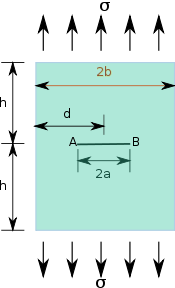 Crack in a finite plate under mode I loading. |
Edge crack in a plate under uniaxial stress
|
For a plate of dimensions containing an edge crack of length , if the dimensions of the plate are such that and , the stress intensity factor at the crack tip under an uniaxial stress is For the situation where and , the stress intensity factor can be approximated by Specimens of this configuration are commonly used in fracture toughness testing.[8] |
 Edge crack in a finite plate under uniaxial stress. |
Slanted crack in a biaxial stress field
|
For a slanted crack of length in a biaxial stress field with stress in the -direction and in the -direction, the stress intensity factors are [3][9] where is the angle made by the crack with the -axis. |
 A slanted crack in a thin plate under biaxial load. |
Crack in a plate under point in-plane force
|
Consider a plate with dimensions containing a crack of length . A point force with components and is applied at the point () of the plate. For the situation where the plate is large compared to the size of the crack and the location of the force is relatively close to the crack, i.e., , , , , the plate can be considered infinite. In that case, for the stress intensity factors for at crack tip B () are [9][10] where with , , for plane strain, for plane stress, and is the Poisson's ratio. The stress intensity factors for at tip B are The stress intensity factors at the tip A () can be determined from the above relations. For the load at location , Similarly for the load , |
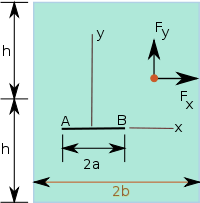 A crack in a plate under the action of a localized force with components and . |
Loaded crack in a plate
|
If the crack is loaded by a point force located at and , the stress intensity factors at point B are[3] If the force is distributed uniformly between , then the stress intensity factor at tip B is |
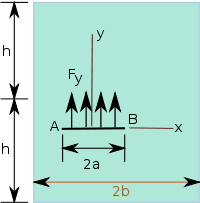 A loaded crack in a plate. |
Stress intensity factors for fracture toughness tests
Compact tension specimen
|
The stress intensity factor at the crack tip of a compact tension specimen is[11] where is the applied load, is the thickness of the specimen, is the crack length, and is the width of the specimen. |
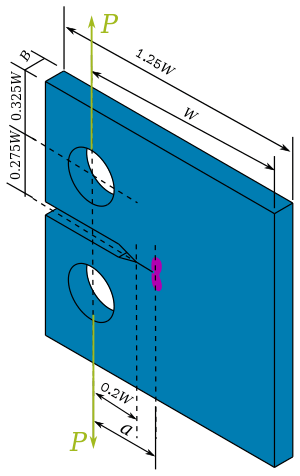 Compact tension specimen for fracture toughness testing. |
Single edge notch bending specimen
|
The stress intensity factor at the crack tip of a single edge notch bending specimen is[11] where is the applied load, is the thickness of the specimen, is the crack length, and is the width of the specimen. |
 Single edge notch bending specimen (also called three point bending specimen) for fracture toughness testing. |
See also
References
- ↑ Anderson, T.L. (2005). Fracture mechanics: fundamentals and applications. CRC Press.
- ↑ Hiroshi Tada; P. C. Paris; George Rankine Irwin (February 2000). The Stress Analysis of Cracks Handbook (3 ed.). American Society of Mechanical Engineers.
- 1 2 3 4 5 6 7 Rooke, D.P. & Cartwright, D.J. (1976). Compendium of stress intensity factors. HMSO Ministry of Defence. Procurement Executive.
- ↑ Sih, G. C. & Macdonald, B. (1974), "Fracture mechanics applied to engineering problems-strain energy density fracture criterion", Engineering Fracture Mechanics, 6 (2): 361–386, doi:10.1016/0013-7944(74)90033-2
- ↑ Sneddon, I. N. (1946), "The distribution of stress in the neighbourhood of a crack in an elastic solid", Proceedings of the Royal Society A, 187 (1009): 229, Bibcode:1946RSPSA.187..229S, doi:10.1098/rspa.1946.0077
- ↑ Isida, M., 1966, Stress intensity factors for the tension of an eccentrically cracked strip, Transactions of the ASME Applied Mechanics Section, v. 88, p.94.
- ↑ Kathiresan, K., Brussat, T. R., & Hsu, T. M. (1984). "Advanced life analysis methods. Crack Growth Analysis Methods for Attachment Lugs," Flight Dynamics Laboratory, Air Force Wright Aeronautical Laboratories, AFSC W-P Air Forec Base, Ohio, Report No. AFWAL-TR-84-3080.
- ↑ Gross, D. & Seelig, T. (2011). Fracture mechanics: with an introduction to micromechanics. Springer.
- 1 2 Sih, G. C., Paris, P. C. and Erdogan, F. (1962), "Crack-tip stress intensity factors for the plane extension and plate bending problem", Journal of Applied Mechanics, 29: 306–312, Bibcode:1962JAM....29..306S, doi:10.1115/1.3640546
- ↑ Erdogan, F. (1962), "On the stress distribution in plates with collinear cuts under arbitrary loads", Proceedings of the Fourth US National Congress of Applied Mechanics, 1: 547–574
- 1 2 Bower, A. F. (2009). Applied mechanics of solids. CRC Press.
External links
- Kathiresan, K. ; Hsu, T. M. ; Brussat, T. R., 1984, Advanced Life Analysis Methods. Volume 2. Crack Growth Analysis Methods for Attachment Lugs
- Stress Intensity Factor on www.fracturemechanics.org, by Bob McGinty
